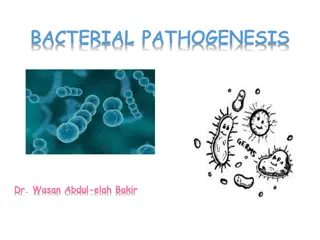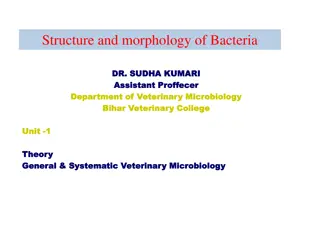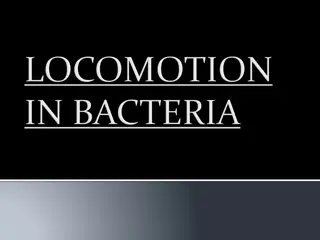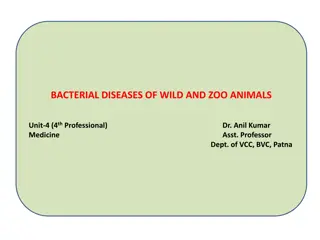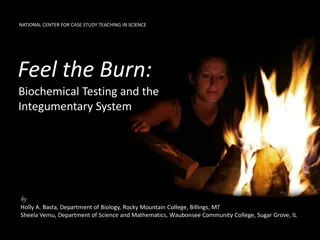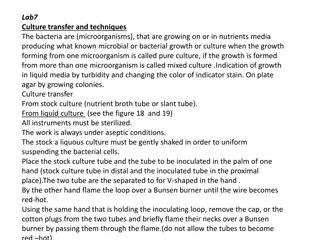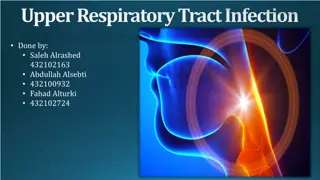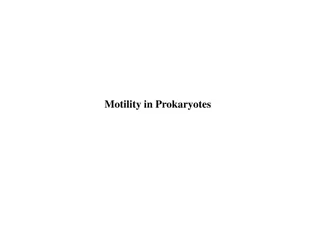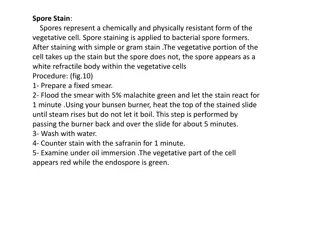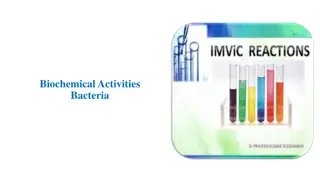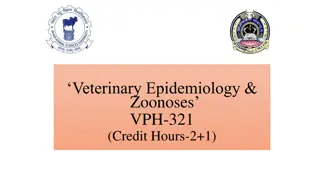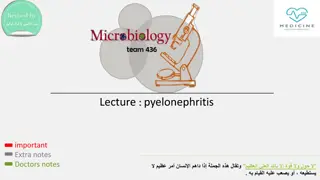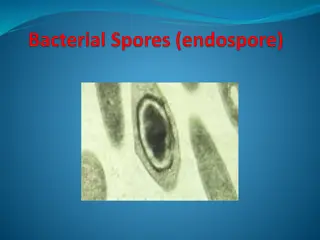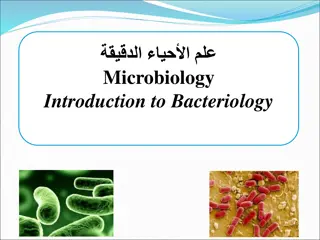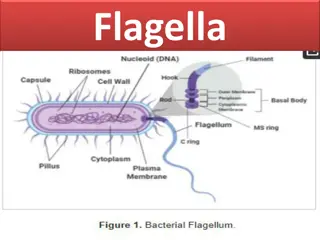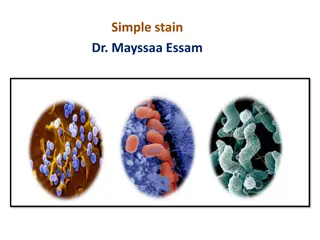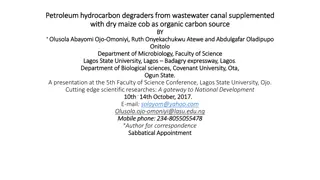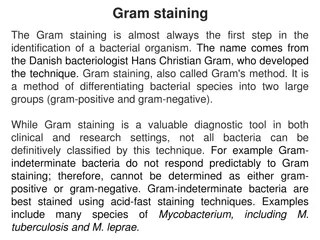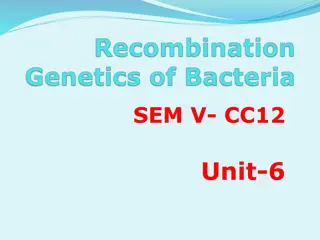Wales in a global context: enhancing learners’ skills
World of bacteria through the lens of mathematics and science. This educational material delves into the characteristics, importance, and impact of bacteria on the environment and human health. From their small single-celled structures to their role in ecosystems, learn about the significance of bac
0 views • 10 slides
Understanding Bacterial Pathogenesis: Key Concepts and Factors
Bacterial pathogenesis involves the ability of certain bacteria to cause disease by attributes such as transmissibility, adherence, motility, invasion, and toxigenicity. Pathogens can exploit host defenses, while virulence determines the severity of infection. Learn about opportunistic pathogens, no
7 views • 36 slides
Understanding Bacterial Toxins and Cell Damage
Bacterial toxins are poisonous substances produced by microbes that can cause harm to host cells through direct damage, toxin production, and hypersensitivity reactions. Toxigenesis is a crucial mechanism used by bacterial pathogens to induce disease, with endotoxins and exotoxins playing distinct r
2 views • 28 slides
Anaerobic Bacterial Infections: Overview and Clinical Implications
Anaerobic bacterial infections are caused by bacteria that do not require oxygen for growth, posing challenges in diagnosis and treatment. This article delves into the types of anaerobic bacteria, their role in human infections, and common clinical presentations such as abscess formation. Gram-negat
2 views • 24 slides
Bacterial Cell Structure and Composition Overview
Bacterial cells exhibit variations in size, typically ranging from 0.75 to 1.5 micrometers. The cell envelope, comprising glycocalyx, cell wall, and cell membrane, plays crucial roles in protection and cell function. The cell membrane, a thin barrier rich in phospholipids and proteins, is integral t
1 views • 28 slides
Understanding Bacterial Physiology and Growth
Bacterial physiology encompasses the growth, nutrition, and metabolism of bacteria. Bacterial growth involves binary fission, generation time, colony formation, and is influenced by various factors such as temperature, atmosphere, moisture, and radiation. Understanding the classification based on te
0 views • 33 slides
Overview of Bacterial Structure and Morphology in Veterinary Microbiology
Bacteria are single-celled prokaryotic organisms with a simple body design. Their structure includes layers such as the extramural layer, surface appendages like flagella and pili, cell envelop with a cell wall and cytoplasmic membrane, and cytoplasmic inclusions. The capsule and slime layer play es
0 views • 21 slides
Understanding Bacterial Spores: Structure, Formation, and Germination
Bacterial spores, the highly resistant resting stage of bacteria, are formed in unfavorable conditions. This article explores the structure of a spore, the process of sporulation, and germination stages. Learn about the shape and position of spores, as well as sporicidal agents that are effective ag
0 views • 13 slides
Exploring Bacterial Flagella: Structure and Function
Bacterial flagella are long, thin appendages crucial for motility in bacteria. Composed of filament, basal body, and hook, these structures play a vital role in bacterial movement. This article dives into the detailed structure and functionality of bacterial flagella, highlighting their importance i
0 views • 9 slides
AP Biology FRQ Practice
Bacterial growth over time and the effects of hypertension on blood vessels are analyzed in this FRQ practice. Factors influencing the growth curve, bacterial advantages in molecular research, and limitations in studying eukaryotic gene expression are explored. Additionally, the interaction of ouaba
1 views • 40 slides
Understanding Bacterial Locomotion: Flagellar Structure and Movement Mechanism
Bacterial locomotion involves intricate flagellar structures composed of filaments, basal bodies, and hooks. The synthesis of flagella is a complex process controlled by numerous genes. The rotation of the flagellar helix acts as a motor, determining the direction of bacterial movement.
1 views • 12 slides
Bacterial Diseases Impacting Wild and Zoo Animals: An Overview
Learn about anthrax, tuberculosis, and salmonellosis, three significant bacterial diseases affecting wild and zoo animals. Understand their etiology, hosts, transmission, diagnosis, prevention, and treatment to safeguard animal populations effectively.
0 views • 11 slides
Understanding Bacterial Photosynthesis: Types and Processes
Photosynthesis is the conversion of light energy into chemical energy, crucial for growth and production of ATP. Prokaryotes such as cyanobacteria, purple and green bacteria, and halobacteria demonstrate different forms of photosynthesis. Oxygenic photosynthesis, found in cyanobacteria, releases oxy
2 views • 20 slides
Burn Injury Complications and Treatment: A Case Study
Alison, a young woman with a burn foot injury, undergoes skin grafting which leads to inflammation and bacterial infection. Despite antibiotic treatment, she develops bacteremia and an abscess. The case study explores burn degrees, skin layers, graft types, inflammation causes, bacterial identificat
1 views • 11 slides
Introduction to Phage DNA Integration in Bacterial Cells
Phage DNA can be introduced into bacterial cells through two methods: transfection and in vitro packaging. Transfection involves mixing purified phage DNA with competent E. coli cells, inducing DNA uptake via heat shock. In vitro packaging utilizes proteins coded by the phage genome, which can be pr
1 views • 13 slides
Bacterial Culture Transfer Techniques and Growth Indicators
Bacterial cultures can be transferred using aseptic techniques to ensure purity. Growth indicators such as turbidity in liquid media and colonies on agar plates signify microbial growth. Proper sterilization and handling of instruments are crucial in the process. Techniques like streaking on agar pl
1 views • 4 slides
Pulsed-Field Gel Electrophoresis: Separating Large DNA Molecules
Pulsed-Field Gel Electrophoresis (PFGE) is a technique developed to effectively separate large DNA molecules through the application of an electric field that periodically changes direction. This method, introduced by David C. Schwartz and Charles C. Cantor in 1984, revolutionized the resolution of
1 views • 11 slides
Differentiating between Viral and Bacterial Infections in Upper Respiratory Tract
Understanding the distinction between viral and bacterial upper respiratory tract infections is crucial for effective management and treatment. This article discusses key differences in symptoms, diagnostic methods, and treatment approaches to aid in accurate differentiation between the two types of
2 views • 87 slides
Exploring Motility in Prokaryotes: Flagellar, Spirochaetial, and Gliding Movements
Delve into the fascinating world of bacterial motility through three types of movements in prokaryotes: flagellar movement driven by rotating flagella, spirochaetial movement with flexible axial fibrils, and gliding movement observed in certain bacteria on solid surfaces. Additionally, discover how
1 views • 14 slides
Bacterial Staining Techniques Overview
Spore staining, acid-fast staining, and negative staining are essential techniques in microbiology for differentiating bacterial structures based on staining properties. Spore staining highlights spore formers, acid-fast staining differentiates acid-fast bacteria, and negative staining detects capsu
5 views • 6 slides
Insights into Tyzzer's Disease: An Overview of a Bacterial Infection in Laboratory Animals
Tyzzer's disease is an acute bacterial infection affecting rodents and rabbits, caused by Clostridium piliforme. Discovered in 1917 by Ernest Tyzzer, the disease is characterized by necrotic lesions in the caecal mucosa, liver, and heart. Initially known as Bacillus piliformis, it was later renamed
2 views • 21 slides
Understanding Microbial Nutrition and Bacterial Physiology
Microbial nutrition involves essential elements required for microbial growth and energy production. Bacterial physiology delves into the structures and functions that enable bacteria to thrive, from cell wall composition to enzyme activities. Major elements like C, O, H, N, S, and P are crucial for
2 views • 20 slides
Understanding Biochemical Tests for Bacterial Identification
Explore the importance of biochemical tests like Triple Sugar Iron Agar and IMViC in identifying enteric bacteria. Learn about indole production and the Methyl Red test, essential in distinguishing bacterial species based on their metabolic activities. Discover how these tests aid in diagnosing food
2 views • 17 slides
Understanding Glanders: A Contagious Bacterial Disease in Animals
Glanders is a contagious bacterial disease primarily affecting equidae but can also infect other animals, including humans. Caused by Burkholderia mallei, it has a historical occurrence and poses risks globally due to its transmission potential. The etiology, survival characteristics, host range, an
0 views • 19 slides
Overview of Bacterial Morphology and Cell Structure
This article discusses the morphology of both Gram-positive and Gram-negative bacteria, highlighting examples of different arrangements and shapes. It also explores the structure and functions of bacterial cell walls, emphasizing the role of teichoic acids in Gram-positive cell walls. Additionally,
1 views • 38 slides
Understanding Pyelonephritis: Key Insights and Management
Pyelonephritis is a serious bacterial infection of the kidneys, leading to renal damage and potentially life-threatening complications. This condition has different etiologies, including ascending bacterial infection and hematogenous spread, with Escherichia coli being the most common causative orga
1 views • 22 slides
Understanding Bacterial Spore Survival and Thermal Death Rates
Survival of bacterial spores during heat processing is crucial for food safety. The concept of Decimal Reduction Time (D value) and Thermal Death Time (TDT) curve help in understanding the thermal destruction of bacteria or spores. The Z value indicates the change in temperature necessary to cause a
6 views • 14 slides
Understanding Bacterial Endospores and Sporulation Process
Bacterial endospores are dormant structures that allow bacteria to survive harsh conditions. They contain vital genetic material and are resistant to drought, heat, radiation, and chemicals. The process of sporulation involves the formation of endospores within bacterial cells, followed by germinati
0 views • 34 slides
Understanding Cloning Vectors and Recombinant DNA Technology
Genetics Engineering Lecture-2 delves into the concept and basic steps of recombinant DNA technology and gene cloning, highlighting different types of cloning vectors like plasmids, bacteriophages, bacterial artificial chromosomes, yeast artificial chromosomes, and mammalian artificial chromosomes.
1 views • 13 slides
Understanding Bacterial Taxonomy and Staining Techniques
Bacterial taxonomy involves classifying and identifying bacteria, while staining techniques such as Gram staining help differentiate between Gram-positive and Gram-negative bacteria. This article discusses the importance of distinguishing bacterial strains, preparing smears, and performing different
0 views • 17 slides
Understanding Bacterial Growth and Reproduction in Microbiology
Bacterial growth involves binary fission where cells divide into two, leading to the formation of new cells. The generation time varies among species. The growth curve consists of lag, exponential, stationary, and death phases, each with distinct characteristics. By understanding these phases, resea
0 views • 15 slides
Understanding Bacterial Flagella: Structure and Function
Bacterial flagella, known as flagellum, are hairlike appendages responsible for swimming motility. They are composed of three parts - the filament, basal body, and hook. The filament is a hollow cylinder made of flagellin protein subunits. The synthesis of flagella involves multiple genes. This arti
0 views • 6 slides
Understanding Bacterial Colony Morphology for Microbiology Analysis
Bacterial colonial morphology plays a crucial role in identifying bacteria and fungi. This exercise focuses on recognizing the cultural characteristics of bacteria on agar plates through colony morphology. Each colony represents a genetically similar group of microorganisms derived from a single cel
1 views • 6 slides
Mechanisms and Role of Horizontally Transferred Genetic Elements in Bacterial Disease Pathogenesis
This presentation explores the transfer of foreign DNA into bacteria, discussing mechanisms such as conjugation, transduction, and transformation. It delves into the significance of Mobile Genetic Elements (MGEs) like plasmids, bacteriophages, and transposons in bacterial virulence and pathogenesis.
0 views • 20 slides
Understanding Bacterial Morphology and Simple Stain Techniques
Explore the characteristics of bacteria based on their shape and structure, grouped into spherical, rod-shaped, and helical types. Learn about bacterial smear preparation principles and the simple stain procedure for observing bacterial cells under a microscope. Discover various bacterial species an
0 views • 13 slides
Evaluation of Petroleum Hydrocarbon Degraders in Wastewater Canal Supplemented with Organic Carbon Source
This study explores the potential of native bacterial populations in wastewater for bioremediation of petroleum hydrocarbon-polluted environments. The research involved exposing Bonny light crude oil to wastewater canal samples supplemented with dry maize cob as an organic carbon source. Results sho
0 views • 26 slides
Bacto-Gum: Revolutionizing Oral Hygiene with Bacterial Technology
Designing a revolutionary tartar removal system, Bacto-Gum aims to enhance oral hygiene by using genetically modified bacteria in a convenient chewing gum form. This innovative approach could potentially prevent oral diseases, improve overall health, reduce dental costs, and make oral hygiene produc
0 views • 21 slides
Understanding Gram Staining in Bacterial Identification
Gram staining is a crucial technique in identifying bacterial organisms, developed by Hans Christian Gram. It involves differentiating bacteria into gram-positive and gram-negative groups based on cell wall properties. Gram staining has five basic steps and helps in determining bacterial characteris
0 views • 15 slides
Bacterial Conjugation: Mechanism and Applications
Bacterial conjugation is the process of transferring genetic material between bacterial cells through direct contact or bridge-like connections. Discovered in 1946, this mechanism enables the transfer of DNA regions between various bacterial species, including Gram-negative and Gram-positive bacteri
0 views • 58 slides
Bacterial Cell Shapes and Simple Stain Procedure
Explore the three basic shapes of bacterial cells - Coccus, Bacillus, and Spiral - and learn about different arrangements within each shape. Dive into the Simple Stain procedure, a straightforward staining technique using single stains like methylene blue and crystal violet, to prepare and visualize
0 views • 32 slides

